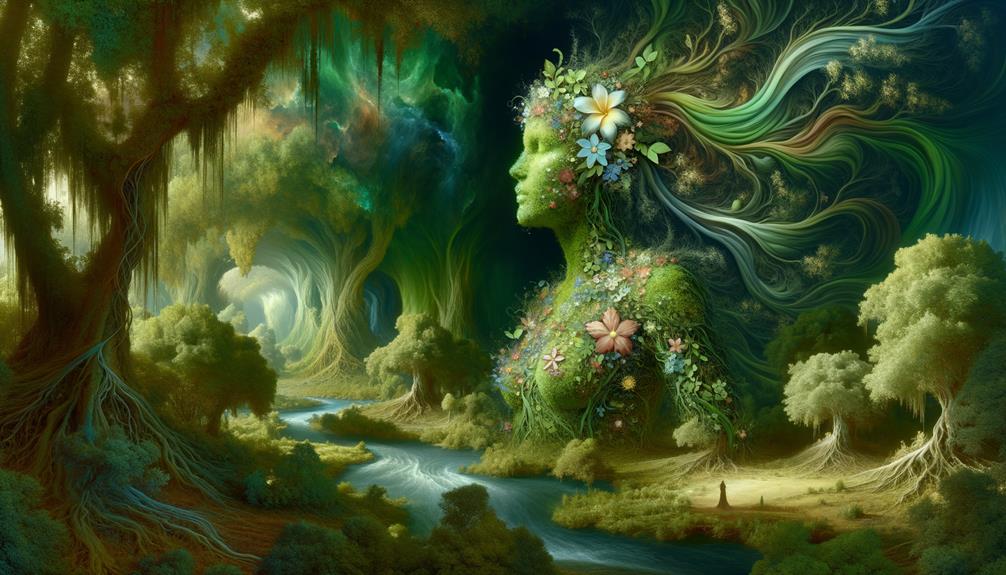Gaia, the primordial mother in Greek mythology, emerged from chaos, birthing the mighty Titans, Cyclopes, and Giants – raw, primal forces. Her union with Uranus sparked celestial struggles and cycles of creation and upheaval. Gaia nurtures and transforms, the Earth's sustaining power personified. Ancient rituals and modern pagans honor her, symbolizing life's interconnected web. Gaia's essence weaves through creation stories, unveiling endless tales of awe and wisdom. Uncover deeper mysteries on this mythic journey.
Origins of Gaia
In Greek mythology, Gaia stood as the ultimate Earth goddess, representing the very essence of our planet. Her origins date back to the primordial chaos before all else existed. As the embodiment of the natural world, she birthed Uranus (the heavens), the Titans, Giants, and Cyclopes – powerful forces that shaped the ancient realms.
The Romans, too, venerated Terra, their equivalent Earth deity, underlining humanity's universal reverence for this archetype. Throughout the Greek regions, temples and sacred sites honored Gaia's role as the nurturing mother, affirming her centrality to life itself.
Gaia's saga resonates as an enduring symbol of the Earth Mother – a timeless figure integral to our comprehension of creation and existence. Her name, translating to 'earth' or 'land,' extends beyond mere geography, encapsulating the very foundation we stand upon.
Gaia in Mythology

Gaia's mythological role casts her as the primordial foundation, birthing the powerful Titans and Giants. Her union with Uranus symbolizes the cosmic marriage of Earth and Sky, a primeval Greek creation tale. Gaia's descendants perpetuate her legacy, their struggles echoing archetypal heroic journeys spanning eternity's scales.
Gaia's Role in Creation
Gaia's birth from chaos marks Earth's beginning and the origins of Greek mythology. As the Earth goddess, her role in creation stories holds profound importance. She embodies the primordial deity from which the world emerges. Within Greek myths, Gaia represents Earth itself, nurturing subsequent generations of gods and titans.
Her significance encompasses several aspects:
- Source of Life: Gaia's emergence signals the cosmos' start and Earth's formation, bringing substance to the universe.
- Progenitor of Titans and Giants: Her union with other primordial beings leads to powerful entities like the Titans and Giants, pivotal characters in mythological narratives.
- Guardian of Balance: As the Earth goddess, she maintains nature's equilibrium, ensuring life's cycles continue uninterrupted.
These symbols underscore Gaia's central role in cosmogony and the world's evolution. Her story reflects life's interconnectedness and her pivotal part in Earth's creation.
Gaia and Uranus
Few relationships in Greek myths resonate as deeply as Gaia and Uranus'. Gaia, the Earth goddess, birthed Uranus, the sky deity. Their union marked the origin of the cosmic order, producing the Titans, Cyclopes, and Hecatoncheires—figures pivotal to mythological narratives.
Tensions brewed between Gaia and Uranus. Fearing his children's might, Uranus imprisoned them within Gaia's womb, an oppressive act that ignited Gaia's fury. She conspired with her Titan son Cronus, arming him with a sickle to overthrow Uranus. This rebellion liberated the Titans while affirming Gaia's role in maintaining cosmic equilibrium.
Gaia and Uranus' turbulent bond symbolizes creation, rebellion, and transformation in Greek mythology. As an Earth goddess, Gaia's influence permeated the fabric of the divine realm, her story with Uranus intertwining with the destinies of gods and mortals.
Gaia's Offspring and Legacy
Gaia's offspring lay at the mythological heart of ancient Greek creation stories, symbolizing life's interconnected nature. As the Earth Mother, her children weren't simply beings but elemental forces shaping existence.
The mighty Titans like Cronus and Rhea embodied cosmic struggle – defying Uranus' reign initiated pivotal upheaval. Meanwhile, the Giants, born from Gaia's union with Uranus' spilled blood, represented primal, chaotic energy vying for dominance.
Other formidable progeny included the Cyclopes, whose single, piercing eye symbolized focused power, and the hundred-handed Hecatoncheires, avatars of overwhelming natural force.
Gaia's fertility extended to sea gods like the bountiful Nereus and rustic deities like the wild Kouretes, personifying nature's untamed aspects.
Her children formed a vivid tapestry depicting the perpetual cosmic dance – creation and destruction intertwined, order and chaos entwined, fertility and decay locked in an eternal cycle. Gaia's mythic legacy illustrated the earth's role as the crucible of existence itself.
Gaia's Offspring
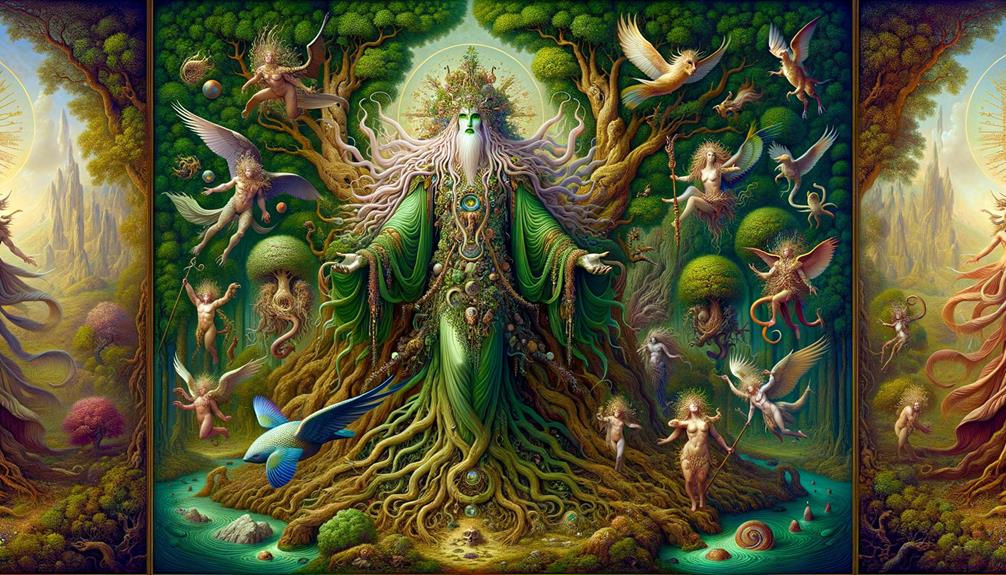
In Greek myths, Gaia's children represented primal forces and elements. The Titans embodied cosmic order and chaos, while the Giants were born to defy the gods. The one-eyed Cyclopes symbolized raw power, and the hundred-handed Hecatoncheires stood for overwhelming strength.
Gaia's union with Pontus birthed sea deities like Nereus, Thaumas, and Ceto, reflecting her ties to watery realms. These beings governed oceanic mysteries, highlighting Gaia's nurturing yet tumultuous nature. The Erinyes, born from Gaia and Uranus, were relentless justice enforcers embodying Gaia's moral compass.
Other offspring like Aether and Hemera represented light and day, while Echidna and Aphrodite revealed Gaia's paradoxical monstrosity and beauty. Through her diverse progeny, Gaia's essence permeated creation and evolution in Greek mythology, cementing her significance.
Gaia's Cult and Worship
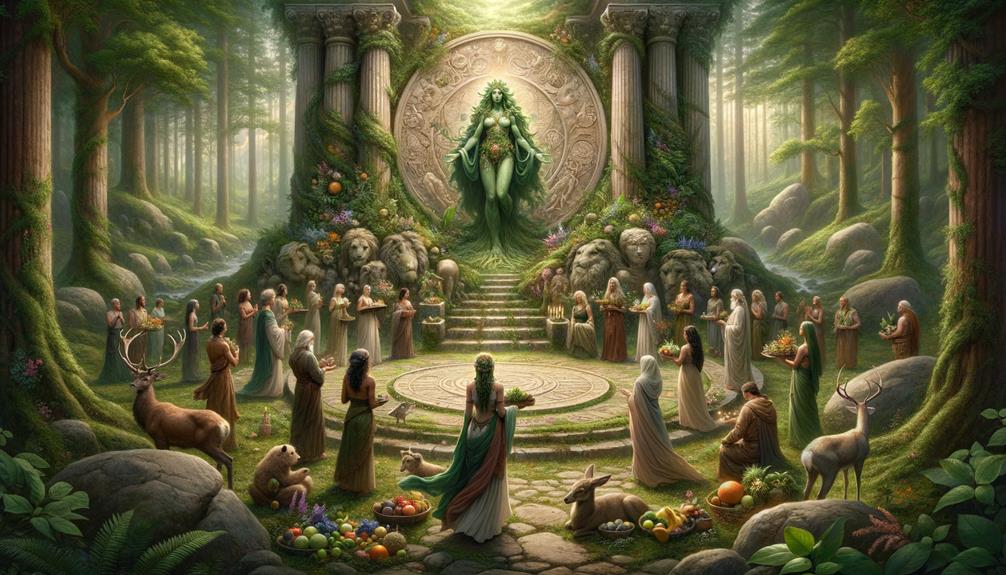
Gaia's worship harnessed the deep reverence ancient Greeks held for the Earth. Her followers viewed her as the primordial mother, an embodiment of the nurturing force sustaining all life. Sacred sites dotted Greece, where rituals and ceremonies took place.
The veneration of Gaia involved:
- Priestesses: Women led the rites and maintained sanctuaries regardless of marital status, highlighting the inclusive nature.
- Rituals: Ceremonies, competitions, and offerings honored Gaia's spirit by symbolizing the cycles of life, death, and rebirth.
- Temples: The traveler Pausanias documented three shrines dedicated solely to Gaia, focal points for communities' spiritual lives.
Through these practices, worshippers fostered a profound bond with the Earth, acknowledging its divine presence.
Interpretations of Gaia
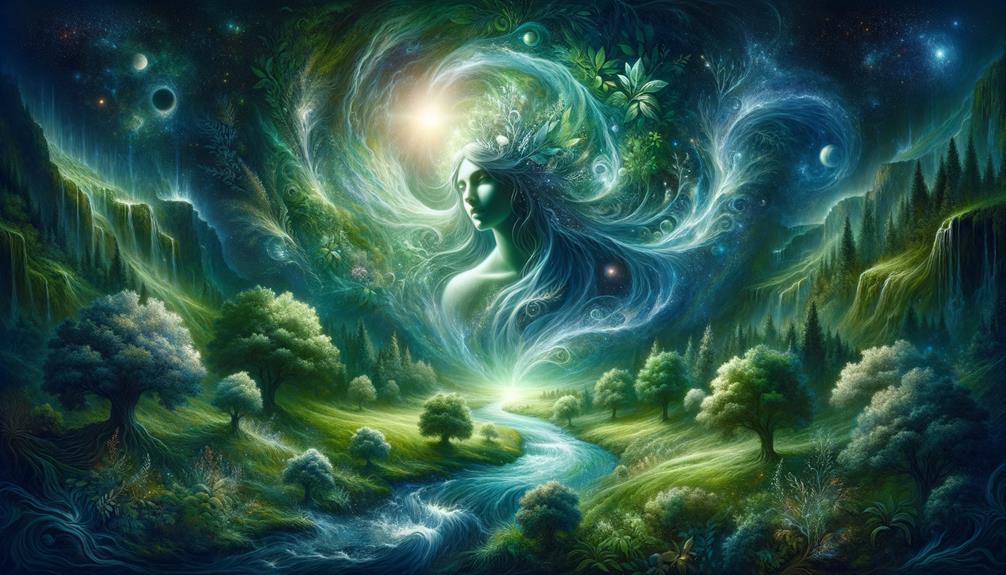
Gaia resonates as both an ancient Neolithic motherly figure and a symbol of modern environmental awareness. Her nurturing spirit and deep ties to life and nature find expression in today's cultural and artistic realms. Gaia's evolution from mythic origins to contemporary icon highlights her lasting impact as the Earth's primal caregiver.
Gaia's Symbolic Representations
Gaia, the mother goddess rooted in ancient Greek myths, personifies the Earth itself. Her symbolism reflects nature's cycles and interdependence of all living things.
In Greek mythology, Gaia embodied these vivid representations:
- The Earth: Gaia depicted as the nurturing, life-giving foundation upon which creation thrives.
- Fertility: She symbolized nature's lushness and life's continual renewal, highlighting the Earth's abundant fecundity.
- Interconnectedness: Gaia emphasized the intricate web where every creature and element interconnects, portraying her as both life's origin and sustainer.
Her symbolism captures the Earth's essence through cycles and connections. Gaia reflects humanity's ancient reverence for the planet's restorative power.
Gaia in Modern Culture
Gaia, an ancient archetype of the primordial goddess representing Earth, has made a resurgence in modern culture. Her mythological roots intertwine with our present-day environmental awareness. James Lovelock's Gaia hypothesis characterizes Earth as a self-regulating living system, propelling Gaia into a symbol of ecological unity.
Contemporary works portray Gaia as nature's nurturing force, embodying the interconnectedness of all life. Her presence highlights Earth's vulnerability, compelling us toward responsible environmental stewardship. Gaia's journey from ancient myth to modern icon stems from our collective desire to reconnect with the planet.
As we navigate environmental challenges, Gaia reminds us of our roles within Earth's intricate web. Her narrative transcends ancient texts, becoming a rallying cry for unity in protecting our shared home.
Gaia in Modern Paganism
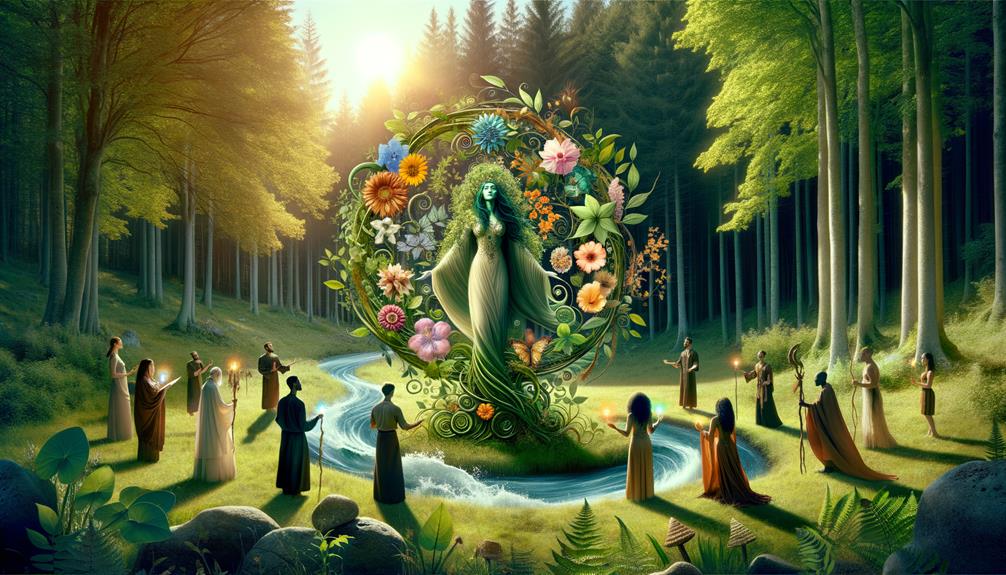
Gaia represents a profound connection with the natural world for modern pagans. She embodies Earth's nurturing spirit and the intricate web of life it sustains. Venerating Gaia instills deep respect for our planet and encourages sustainable living.
Rituals honoring Gaia involve offerings like flowers and herbs, symbolizing gratitude for Earth's bounty. These ceremonies strengthen one's bond with nature. Modern pagans champion eco-friendly practices, aiming to live harmoniously with the environment. A core belief is that all life interconnects, urging recognition of our roles within the ecological tapestry.
Celebrations center around appreciating Gaia's generosity and striving for balance. Pagans use natural elements to represent Earth's cycles, reinforcing humanity's place within the greater scheme. From planting trees to recycling, daily actions align with Gaia's reverence. The overarching goal is fostering a symbiotic relationship with our planet for generations to come.
Frequently Asked Questions
Who Is the Goddess Gaia of Earth?
The primordial goddess symbolizing Earth gave birth to the sky, Titans, and giants. Gaia represents the archetypal mother figure, embodying fertility, creation, and the nurturing essence that sustains all life.
Was Gaia a Primordial God?
Gaia surfaced at the dawn of creation, embodying the very Earth itself. As an archetypal figure, her essence encapsulates the world's fertility and abundance, giving birth to gods, titans, and mythic beings. The primordial goddess represents the planet's life-sustaining forces, playing a pivotal role in ancient Greek mythology.
Why Did Gaia Marry Her Son?
Gaia, the primordial goddess of Earth, united with her son Uranus, representing the heavens, in an intimate bond. Their cosmic marriage symbolized nature's constant cycle of creation and destruction. However, this primeval union bred generational strife, setting the stage for the emergence of the mighty Titans and the establishment of the universe's fundamental order.
What Is the Difference Between Gaia and Gaea?
Gaia and Gaea refer to the primordial earth goddess from ancient mythology. Gaia is the modern spelling, while Gaea represents the ancient form. Both names symbolize the nurturing essence of earth, embodying archetypal symbols of creation.
In simpler terms, Gaia and Gaea are different spellings for the same goddess representing Mother Earth. Gaia is the more commonly used version today, while Gaea is the original ancient spelling. The two names evoke the idea of the earth as a life-giving, creative force.

